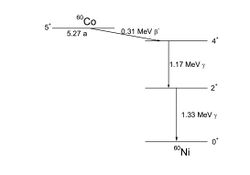Physics:Multipolarity of gamma radiation
Transitions between excited states (or excited states and the ground state) of a nuclide lead to the emission of gamma quanta. These can be classified by their multipolarity.[1] There are two kinds: electric and magnetic multipole radiation. Each of these, being electromagnetic radiation, consists of an electric and a magnetic field.
Multipole radiation
Electric dipole, quadrupole, octupole… radiation (generally: 2[math]\displaystyle{ \ell }[/math]pole radiation) is also designated as E1, E2, E3,… radiation (generally: E[math]\displaystyle{ \ell }[/math] radiation).[note 1]
Similarly, magnetic dipole, quadrupole, octupole… radiation (generally: 2[math]\displaystyle{ \ell }[/math]pole radiation) is designated as M1, M2, M3,… radiation (generally: M[math]\displaystyle{ \ell }[/math] radiation).
There is no monopole radiation ([math]\displaystyle{ \ell= 0 }[/math]).[1]
In quantum mechanics, angular momentum is quantized. The various multipole fields have particular values of angular momentum: E[math]\displaystyle{ \ell }[/math] radiation carries an angular momentum [math]\displaystyle{ \ell }[/math] in units of [math]\displaystyle{ \hbar }[/math]; likewise, M[math]\displaystyle{ \ell }[/math] radiation carries an angular momentum [math]\displaystyle{ \ell }[/math] in units of [math]\displaystyle{ \hbar }[/math]. The conservation of angular momentum leads to selection rules, i.e., rules defining which multipoles may or may not be emitted in particular transitions.
To make a simple classical comparison, consider the figure of the oscillating dipole. It produces electric field lines travelling outwards, intertwined with magnetic field lines, according to Maxwell's equations. This system of field lines then corresponds to that of E1 radiation. Similar considerations hold for oscillating electric or magnetic multipoles of higher order.
Conversely, it is plausible that the multipolarity of radiation can be determined from the angular distribution of the emitted radiation.
Quantum numbers and selection rules
A state of a nuclide is described by its energy above the ground state, by its angular momentum J (in units of [math]\displaystyle{ \hbar }[/math]), and by its parity, i.e., its behaviour under reflection (positive + or negative −). Since the spin of nucleons is ½ (in units of [math]\displaystyle{ \hbar }[/math]), and since orbital angular momentum has integer values, J may be an integer or a half integer number.
Electric and magnetic multipole radiations of the same order [math]\displaystyle{ \ell }[/math] (i.e., dipole, or quadrupole...) carry the same angular momentum [math]\displaystyle{ \ell }[/math] (in units of [math]\displaystyle{ \hbar }[/math]), but differ in parity. The following relations hold for [math]\displaystyle{ \ell \gt 0 }[/math]:[1]
- Electric multipole radiation: Parity [math]\displaystyle{ = (-1)^{\ell } }[/math]:
- Here, the electric field has parity [math]\displaystyle{ = (-1)^{\ell } }[/math], and the magnetic field [math]\displaystyle{ (-1)^{\ell } }[/math].
- Magnetic multipole radiation: Parity [math]\displaystyle{ = (-1)^{\ell+1} }[/math]:
- Here, the electric field has parity [math]\displaystyle{ = (-1)^{\ell+1} }[/math], and the magnetic field [math]\displaystyle{ (-1)^{\ell+1} }[/math].
The designation "electric multipole radiation" seems appropriate since the major part of that radiation is produced by the charge density in the source;[1] conversely, the "magnetic multipole radiation" is mainly due to the current density of the source.[1]
In electric multipole radiation, the electric field has a radial component; in magnetic multipole radiation, the magnetic field has a radial component.[1]
An example: in the simplified decay scheme of 60Co above, the angular momenta and the parities of the various states are shown (A plus sign means even parity, a minus sign means odd parity). Consider the 1.33 MeV transition to the ground state. Clearly, this must carry away an angular momentum of 2, without change of parity. It is therefore an E2 transition. The case of the 1.17 MeV transition is a bit more complex: going from J = 4 to J = 2, all values of angular momentum from 2 to 6 could be emitted. But in practice, the smallest values are most likely, so it is also a quadrupole transition, and it is E2 since there is no parity change.
See also
Notes
- ↑ The symbol [math]\displaystyle{ \ell }[/math] is used here to distinguish the letter "el" clearly from the numeral "one".
References
 |



